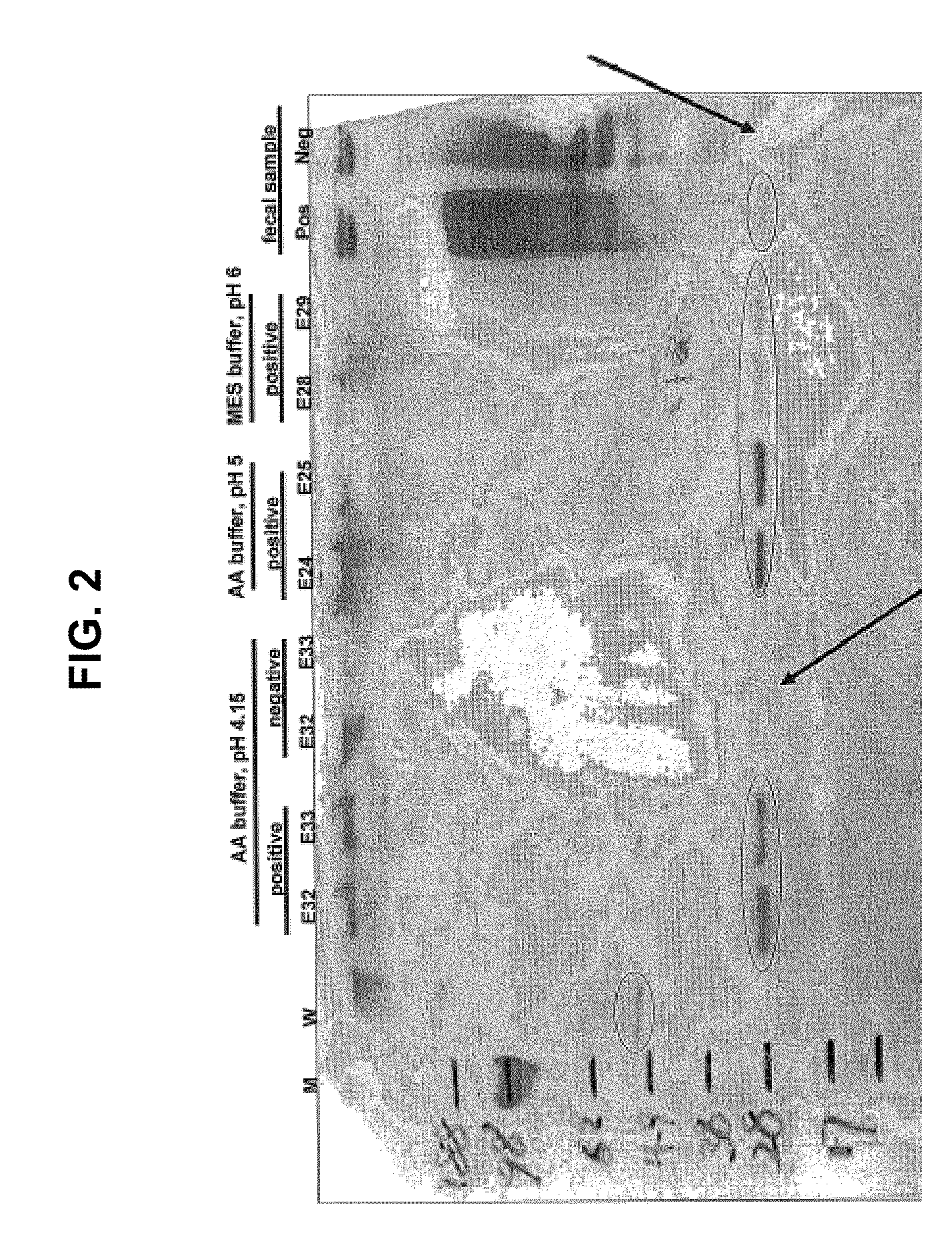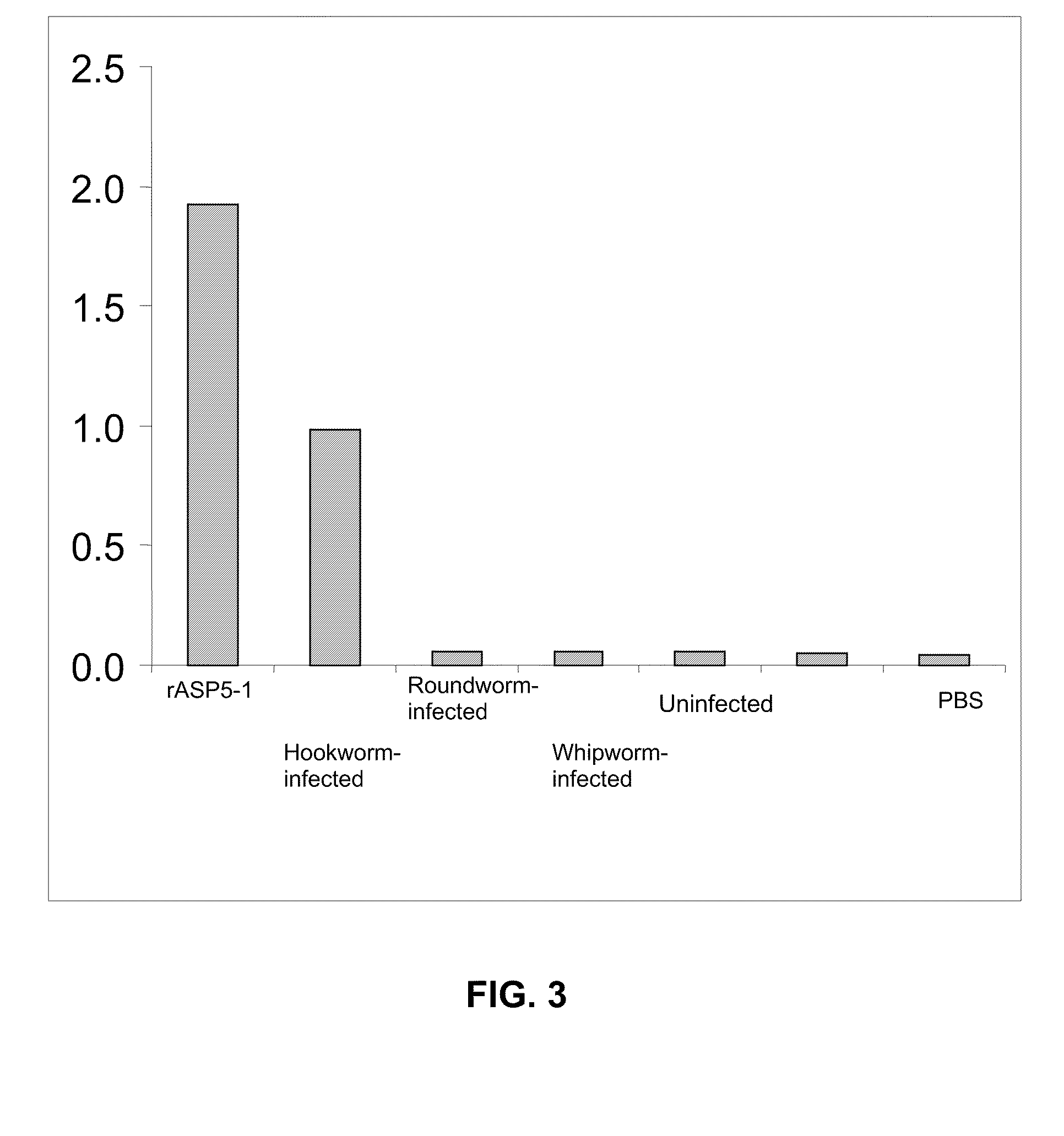Compositions, devices, kits and methods for detecting hookworm
a technology of hookworm and detection kit, which is applied in the field of compositions, devices, kits and methods for the detection of hookworm in mammals, can solve the problems of requiring special equipment, affecting the detection effect, and affecting the quality of the hookworm sample,
- Summary
- Abstract
- Description
- Claims
- Application Information
AI Technical Summary
Benefits of technology
Problems solved by technology
Method used
Image
Examples
example 1
A Novel Isoform of ASP5, which is Herein Referred to as CoproASP5, is Present in Feces of Canines that are Infected with Ancylostoma
[0098]Canine fecal sample preparation. Canine animals known to harbor a hookworm (Ancylostoma caninum) infection or to not have a parasitic worm infection provided the source of fecal samples. A sample (approximately 1 gram) of frozen, unpreserved canine feces pooled from five hookworm-infected or uninfected canines was suspended in 4 ml of extraction buffer (“extraction buffer” is 1× phosphate-buffered saline (PBS), pH 7.0-7.5 with 0.05% TWEEN® 20). This suspension was vortexed for 2 minutes and then was centrifuged at 13,000 rpm for 25 minutes to produce a first supernatant. This first supernatant was then centrifuged at 10,000 rpm for 5 minutes to produce a second supernatant. This second supernatant hereinafter is referred to as “fecal extract”.
[0099]Ion-exchange chromatography. Ion-exchange chromatography was performed by using HITRAP™ SEPHAROSE™ ...
example 2
Antibody Raised Against SEQ ID NO:4 Specifically Binds Coproantigen in Hookworm-Infected Canines, but does not Specifically Bind any Coproantigen in Canines Infected with Roundworm or Whipworm
[0104]Polyclonal antibody preparation and isolation. A polyclonal antibody anti-ASP5-1 was raised in rabbit against a polypeptide having amino acid sequence corresponding to SEQ ID NO:4 (i.e. ASP5-1) and purified from serum by using standard methods.
[0105]Briefly, nucleotides 50 through 427 of SEQ ID NO:2 were cloned in-frame into a vector (D8223, which is a derivative of pUC19) to create the plasmid D8339. Specifically, the 129 amino acids of SEQ ID NO:4 that follow the methionine residue at the N-terminus of that sequence correspond to a portion of SEQ ID NO:3 and are encoded for by the cloned portion of SEQ ID NO:2. In the D8339 plasmid, the N-terminal methionine residue was encoded for by vector sequence at the junction of that plasmid where the vector was ligated to the cloned sequence fr...
example 3
Anti-ASP5-1 pAB Detects Hookworm Coproantigen in some Canines as Early as 9 Days After being Infected with Hookworm. Anti-ASP5-1 pAB does not Detect Hookworm in Feces of Canine Animals that have had a Hookworm Infection, but that have been Dewormed
[0114]It was a goal of Example 3 to determine whether anti-ASP5 pAB can detect hookworm coproantigen in hookworm-infected canines before hookworm ova first appear in the feces of those canines. It was another goal of Example 3 to determine whether anti-ASP5 pAB detects hookworm in feces of canine animals that have been rid of a prior hookworm infection.
[0115]Toward these goals, OD values were measured for fecal samples obtained from a first set of five canines and are shown in FIG. 4. These canines, which are identified as “RKY”, “SKZ”, OGY”, “LEY” and “SKZ”, were infected with hookworm on day 0 and were treated with the Interceptor® anthelmintic agent on day 91 after the administration of the infection as described before. Fecal samples w...
PUM
| Property | Measurement | Unit |
|---|---|---|
| mass | aaaaa | aaaaa |
| flow rate | aaaaa | aaaaa |
| temperature | aaaaa | aaaaa |
Abstract
Description
Claims
Application Information
 Login to View More
Login to View More - R&D
- Intellectual Property
- Life Sciences
- Materials
- Tech Scout
- Unparalleled Data Quality
- Higher Quality Content
- 60% Fewer Hallucinations
Browse by: Latest US Patents, China's latest patents, Technical Efficacy Thesaurus, Application Domain, Technology Topic, Popular Technical Reports.
© 2025 PatSnap. All rights reserved.Legal|Privacy policy|Modern Slavery Act Transparency Statement|Sitemap|About US| Contact US: help@patsnap.com



